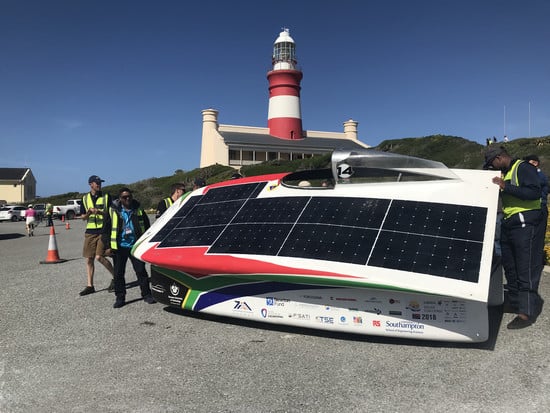The Use of Gridded Model Output Statistics (GMOS) in Energy Forecasting of a Solar Car
Abstract
1. Introduction
2. Materials and Methods
3. Results
GHI Error Improvement
4. Discussion
4.1. Energy Forecasting for a Solar Car in South Africa
4.2. GMOS Benefits to a Solar Car Team
4.3. MOS vs. GMOS Performance
4.4. Further Research Recommendations
5. Conclusions
Author Contributions
Funding
Acknowledgments
Conflicts of Interest
References
- Porter, J. Toyota Is Testing a Much More Efficient Solar Roof for Its Electric Cars. 2019. Available online: https://www.theverge.com/2019/7/5/20683111/toyota-prius-plug-in-hybrid-solar-roof-range-electricity-energy-environment (accessed on 5 February 2020).
- Harrop, P. IDTechEx Explains Significance of Driving Tesla and Squad Solar. 2019. Available online: https://www.idtechex.com/en/research-article/idtechex-explains-significance-of-driving-tesla-and-squad-solar/18881 (accessed on 2 February 2020).
- Lightyear. Lightyear One Designed for performance. 2020. Available online: https://lightyear.one/lightyear-one/ (accessed on 6 January 2020).
- Mambou, E.N.; Swart, T.G.; Ndjiounge, A.R.; Clarke, W.A. Design and implementation of a real-time tracking and telemetry system for a solar car. In Proceedings of the AFRICON 2015, Addis Ababa, Ethiopia, 14–17 September 2015. [Google Scholar]
- Oosthuizen, C.; Wyk, B.V.; Hamam, Y. Modelling and simulation of the South African designed Sun Chaser II solar vehicle. In Proceedings of the 2017 IEEE AFRICON, Cape Town, South Africa, 18–20 September 2017. [Google Scholar]
- Lu, H.; Zhang, Y.; Cai, J. Consistency and differences between remotely sensed and surface observed total cloud cover over China. Int. J. Remote Sens. 2015, 36, 4160–4176. [Google Scholar] [CrossRef]
- Chan, K.L.; Wiegner, M.; Flentje, H.; Mattis, I.; Wagner, F.; Gasteiger, J.; Geiß, A. Evaluation of ECMWF-IFS (version 41R1) operational model forecasts of aerosol transport by using ceilometer network measurements. Geosci. Model Dev. 2018, 11, 3807–3831. [Google Scholar] [CrossRef]
- White, G.; Yang, F.; Tallapragda, V. The Development and Success of NCEP’s Global Forecast System; National Oceanic and Atmospheric Administration: Silver Spring, MD, USA, 2018.
- Radar, V. Top Meteorology Companies. 2019. Available online: https://www.ventureradar.com/keyword/Meteorology (accessed on 4 September 2019).
- Agüera-Pérez, A.; Palomares-Salas, J.C.; de la Rosa, J.J.G.; Florencias-Oliveros, O. Weather forecasts for microgrid energy management: Review, discussion and recommendations. Appl. Energy 2018, 228, 265–278. [Google Scholar] [CrossRef]
- Nespoli, A.; Ogliari, E.; Leva, S.; Pavan, A.M.; Mellit, A.; Lughi, V.; Dolara, A. Day-Ahead Photovoltaic Forecasting: A Comparison of the Most Effective Techniques. Energies 2019, 12, 1621. [Google Scholar] [CrossRef]
- Ruth, D.P.; Glahn, B.; Dagostaro, V.; Gilbert, K. The Performance of MOS in the Digital Age. Weather Forecast. 2009, 24, 504–519. [Google Scholar] [CrossRef]
- Shin, Y.; Yi, C. Statistical Downscaling of Urban-scale Air Temperatures Using an Analog Model Output Statistics Technique. Atmosphere 2019, 10, 427. [Google Scholar] [CrossRef]
- Bofinger, S.; Heilscher, G. Solar electricity forecast: Approaches and first results. In Proceedings of the 21st European Photovoltaic Solar Energy Conference and Exhibition, Dresden, Germany, 4–8 September 2006. [Google Scholar]
- Lorenz, E.; Hurka, J.; Heinemann, D.; Beyer, H.G. Irradiance Forecasting for the Power Prediction of Grid-Connected Photovoltaic Systems. IEEE J. Sel. Top. Appl. Earth Obs. Remote Sens. 2009, 2, 2–10. [Google Scholar] [CrossRef]
- Diagne, M.; David, M.; Boland, J.; Schmutz, N.; Lauret, P. Post-processing of Solar Irradiance Forecasts from WRF Model at Reunion Island. Energy Procedia 2014, 57, 1364–1373. [Google Scholar] [CrossRef]
- Verzijlbergh, R.A.; Heijnen, P.W.; de Roode, S.R.; Los, A.; Jonker, H.J.J. Improved model output statistics of numerical weather prediction based irradiance forecasts for solar power applications. Solar Energy 2015, 118, 634–645. [Google Scholar] [CrossRef]
- Troccoli, A.; Morcrette, J.-J. Skill of Direct Solar Radiation Predicted by the ECMWF Global Atmospheric Model over Australia. J. Appl. Meteorol. Climatol. 2014, 53, 2571–2588. [Google Scholar] [CrossRef]
- Perez, R.; Lorenz, E.; Pelland, S.; Beauharnois, M.; van Knowe, G.; Hemker, K.; Heinemann, D.; Remund, J.; Müller, S.C.; Traunmüller, W.; et al. Comparison of numerical weather prediction solar irradiance forecasts in the US, Canada and Europe. Solar Energy 2013, 94, 305–326. [Google Scholar] [CrossRef]
- Brooks, J.B.; Clou, S.d.; van Niekerk, W.; Gauche, P.; Leonard, C.; Mouzouris, M.J.; Meyer, R.; van der Westhuizen, N.; van Dyk, E.E.; Vorster, F.J. SAURAN: A new resource for solar radiometric data in Southern Africa. J. Energy South. Afr. 2015, 26. [Google Scholar] [CrossRef]
- Kosmopoulos, P.G.; Kazadzis, S.; Lagouvardos, K.; Kotroni, V.; Bais, A. Solar energy prediction and verification using operational model forecasts and ground-based solar measurements. Energy 2015, 93, 1918–1930. [Google Scholar] [CrossRef]
- Fan, J.; Wu, L.; Zhang, F.; Cai, H.; Wang, X.; Lu, X.; Xiang, Y. Evaluating the effect of air pollution on global and diffuse solar radiation prediction using support vector machine modeling based on sunshine duration and air temperature. Renew. Sustain. Energy Rev. 2018, 94, 732–747. [Google Scholar] [CrossRef]
- Ehteram, M.; Najah, A.-M.; Chow, M.F.; Afan, H.; El-Shafie, A. Accuracy Enhancement for Zone Mapping of a Solar Radiation Forecasting Based Multi-Objective Model for Better Management of the Generation of Renewable Energy. Energies 2019, 12, 2730. [Google Scholar] [CrossRef]
- Peters, I.M.; Karthik, S.; Haohui, L.; Buonassisi, T.; Nobre, A. Urban Haze and Photovoltaics. Energy Environ. Sci. 2018, 11, 3043–3054. [Google Scholar] [CrossRef]
- Suthar, M.; Singh, G.K.; Saini, R.P. Effects of air pollution for estimating global solar radiation in India. Int. J. Sustain. Energy 2017, 36, 20–27. [Google Scholar] [CrossRef]
- Gwaze, P.; Mashele, S.H. South African Air Quality Information System (SAAQIS) mobile application tool: Bringing real time state of air quality to South Africans. Clean Air J. 2018, 28, 3. [Google Scholar] [CrossRef]
- Labs, P. World Air Map. 2020. Available online: https://air.plumelabs.com/en/ (accessed on 4 April 2020).
- Gericke, G.A.; Luwes, N.; Mqaqa, V.S. Solar Irradiance Model for the South African Solar Challenge. In 2019 Southern African Universities Power Engineering Conference/Robotics and Mechatronics/Pattern Recognition Association of South Africa (SAUPEC/RobMech/PRASA); IEEE: Piscataway, NJ, USA, 2019. [Google Scholar]
- Meyer, T. Root Mean Square Error Compared to, and Contrasted with, Standard Deviation. Surv. Land Inf. Sci. 2012, 72, 107–108. [Google Scholar]
- Oosthuizen, C.; van Wyk, B.; Hamam, Y.; Desai, D.; Alayli, Y.; Lot, R. Solar Electric Vehicle Energy Optimization for the Sasol Solar Challenge 2018. IEEE Access 2019, 7, 175143–175158. [Google Scholar] [CrossRef]
- Stephens, D.; Shawcross, P.; Stout, G.; Sullivan, E.; Saunders, J.; Risser, S.; Sayre, J. Lithium-Ion Battery Safety Issues for Electric and Plug-in Hybrid Vehicles; National Highway Traffic Safety Administration: Washington, DC, USA, 2017.
- Kwon, H. A study on the resistance force and the aerodynamic drag of Korean high-speed trains. Veh. Syst. Dyn. 2018, 56, 1250–1268. [Google Scholar] [CrossRef]
- Libii, J.N. The determination of the aerodynamic drag force on a parachute. World Trans. Eng. Technol. Educ. 2007, 6, 97. [Google Scholar]
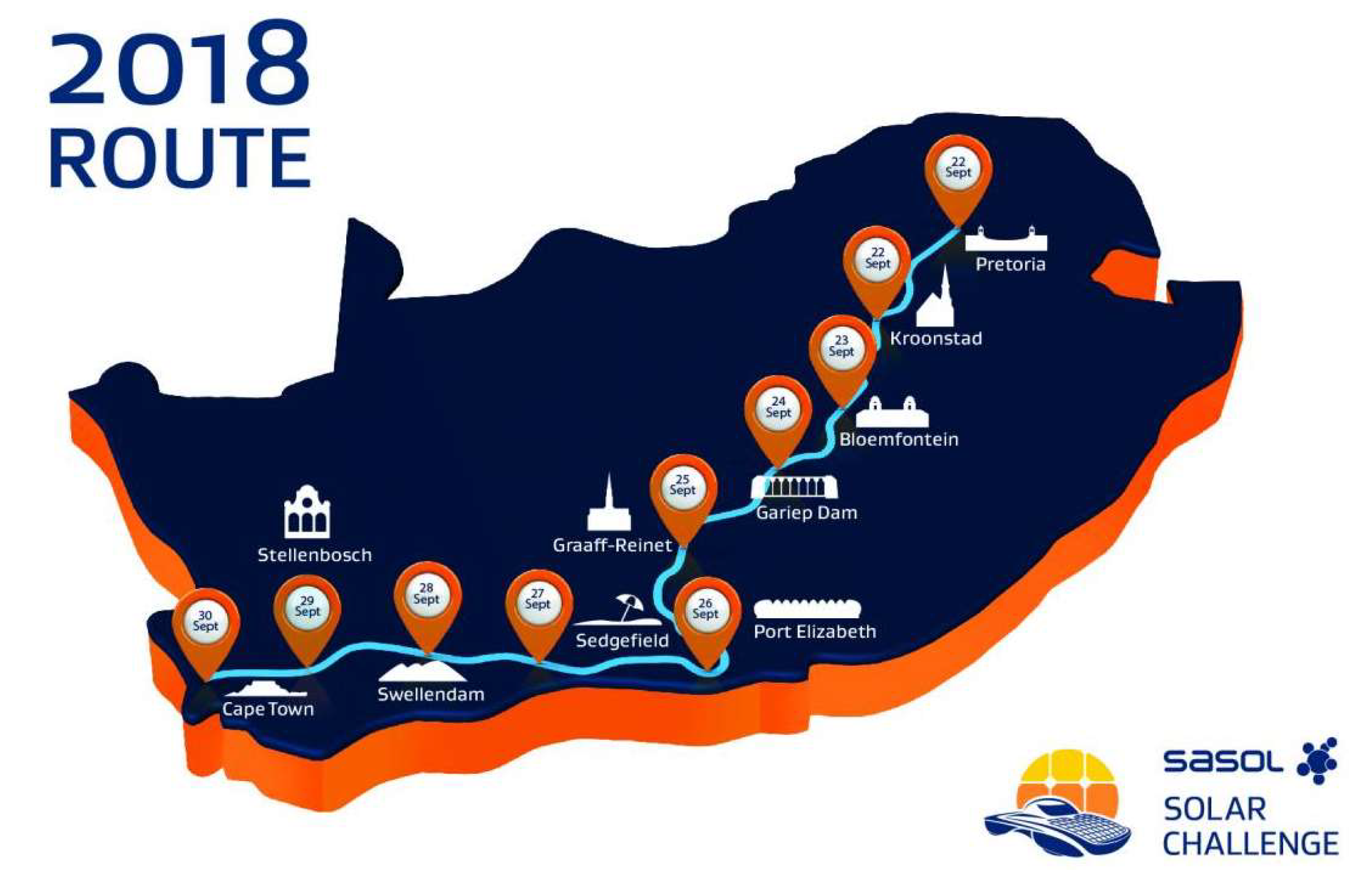
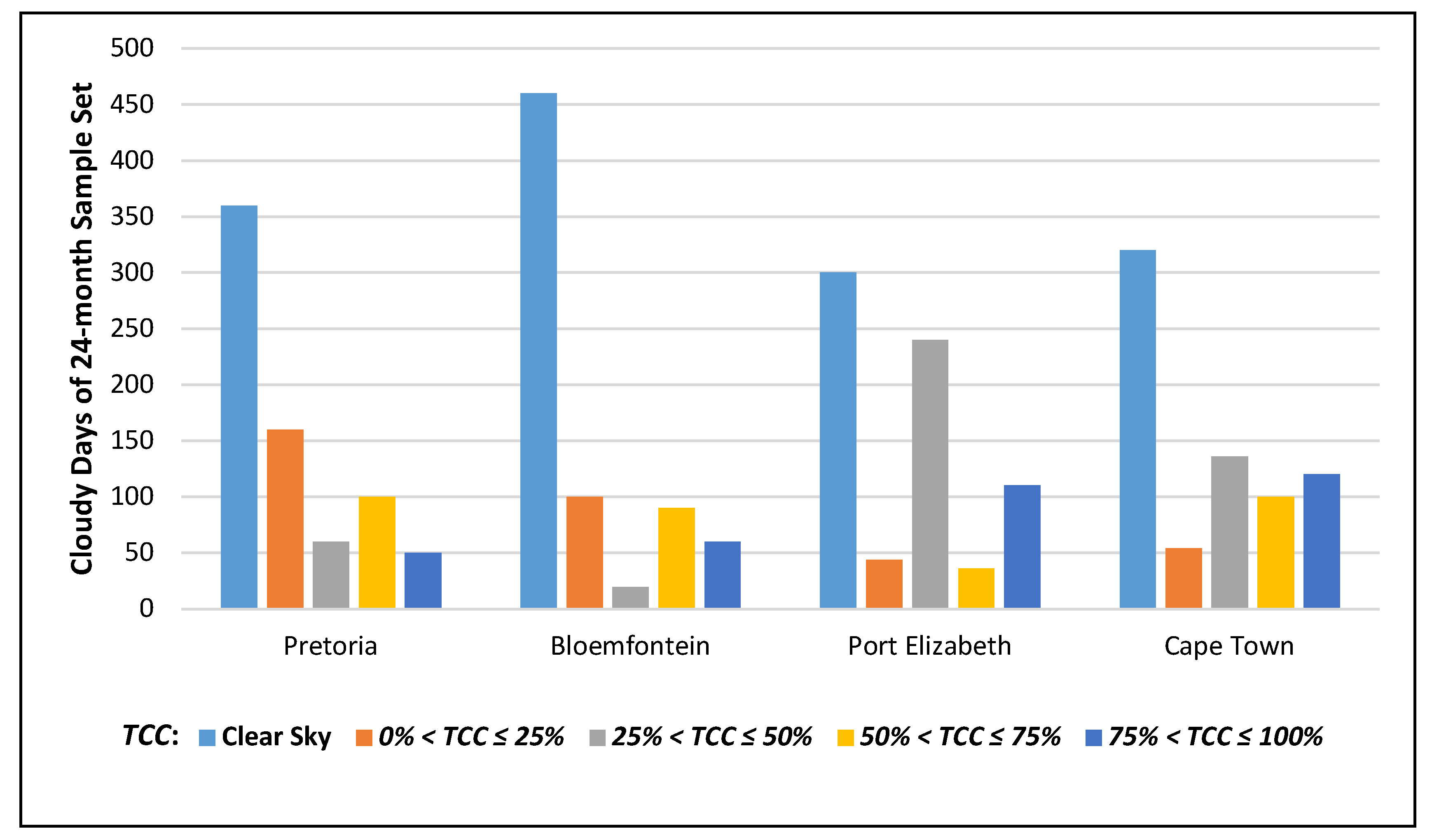
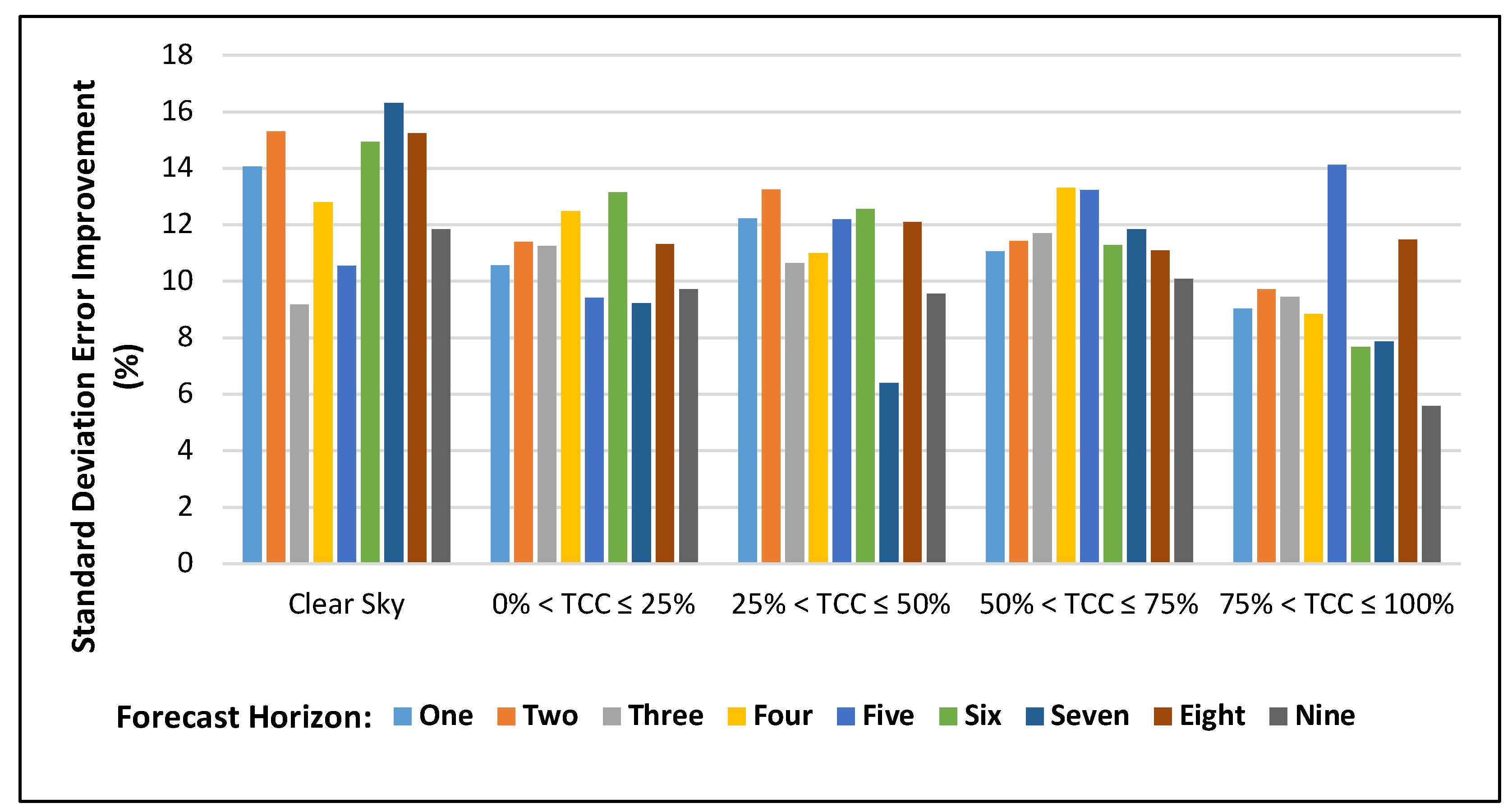
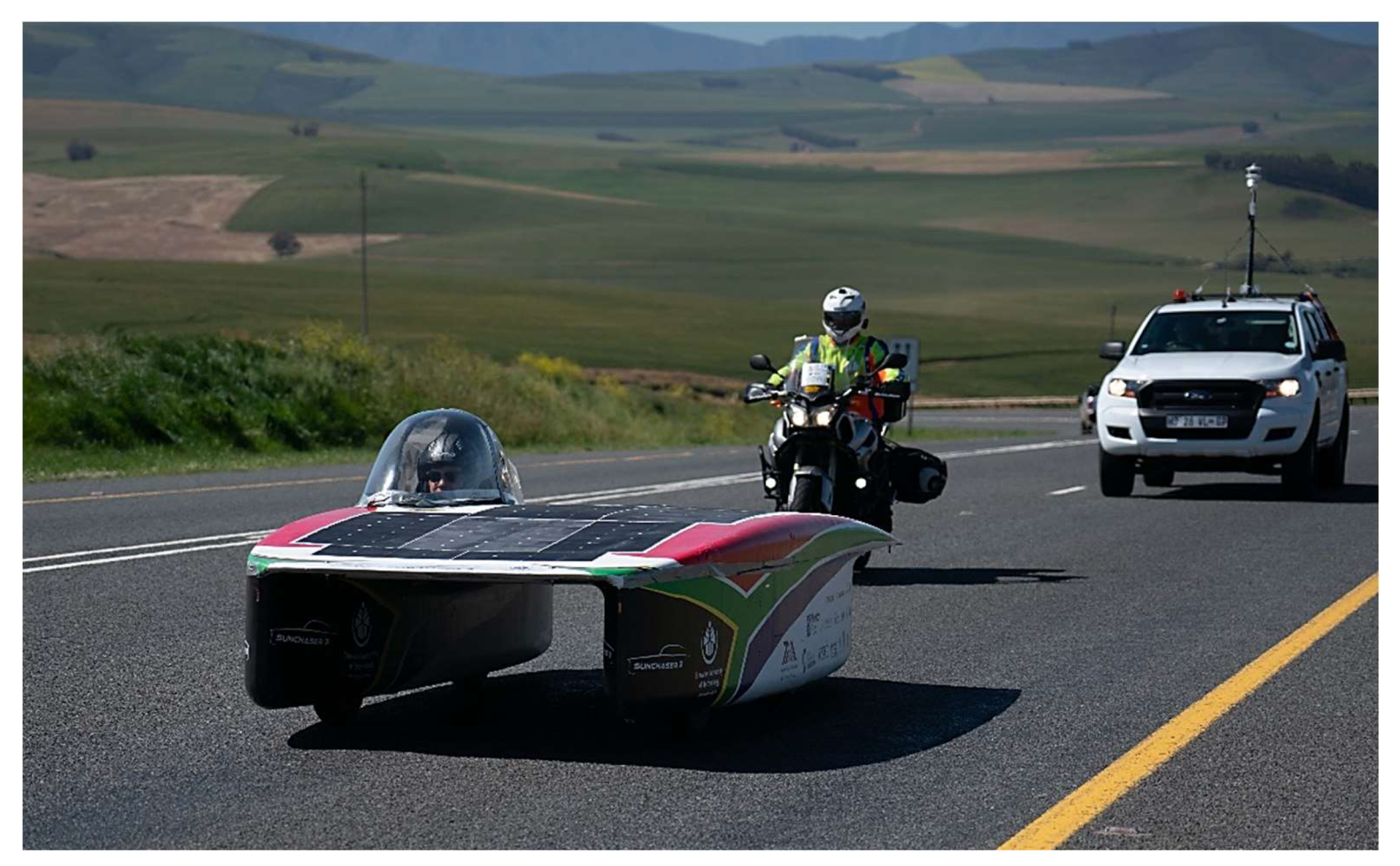
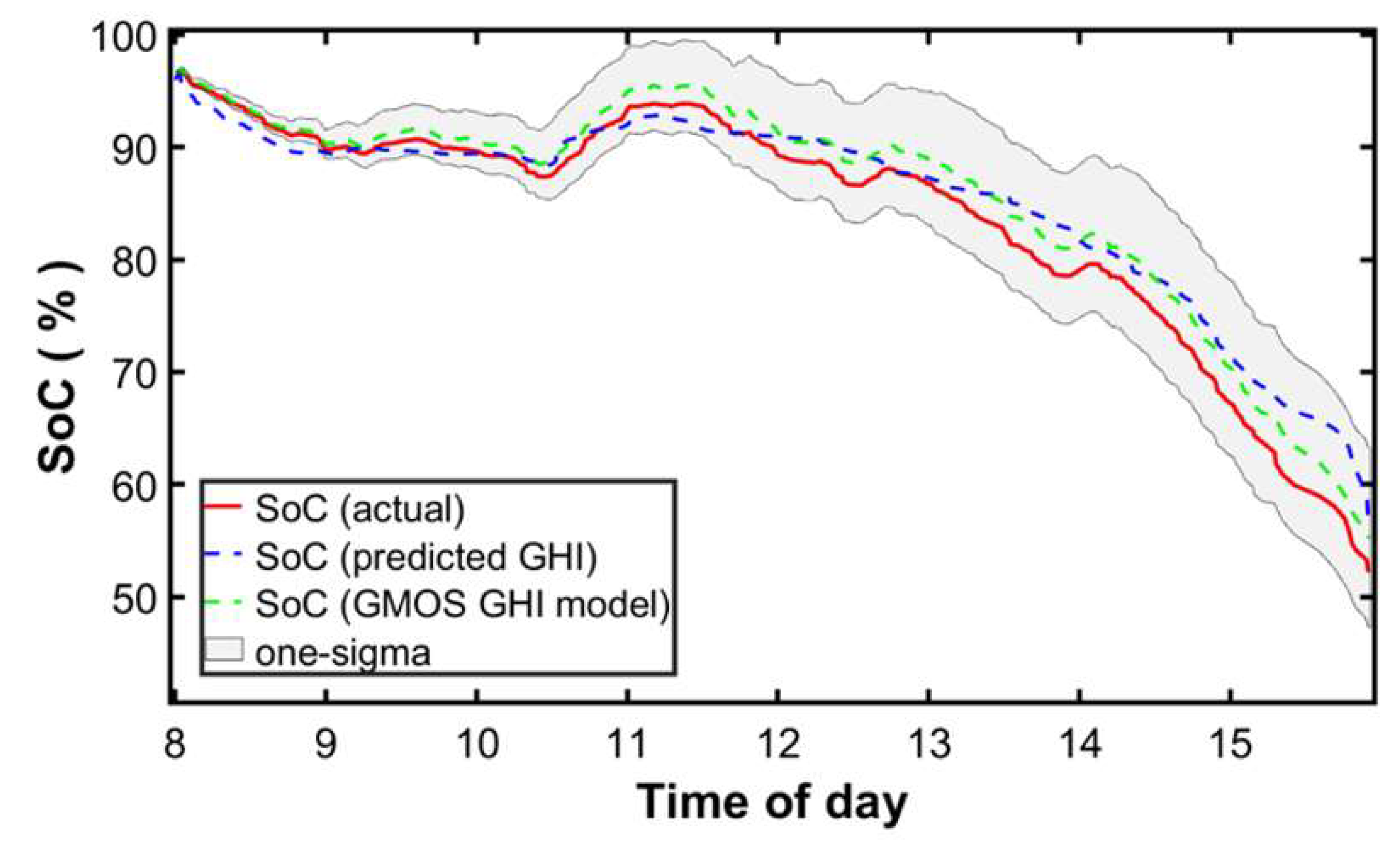

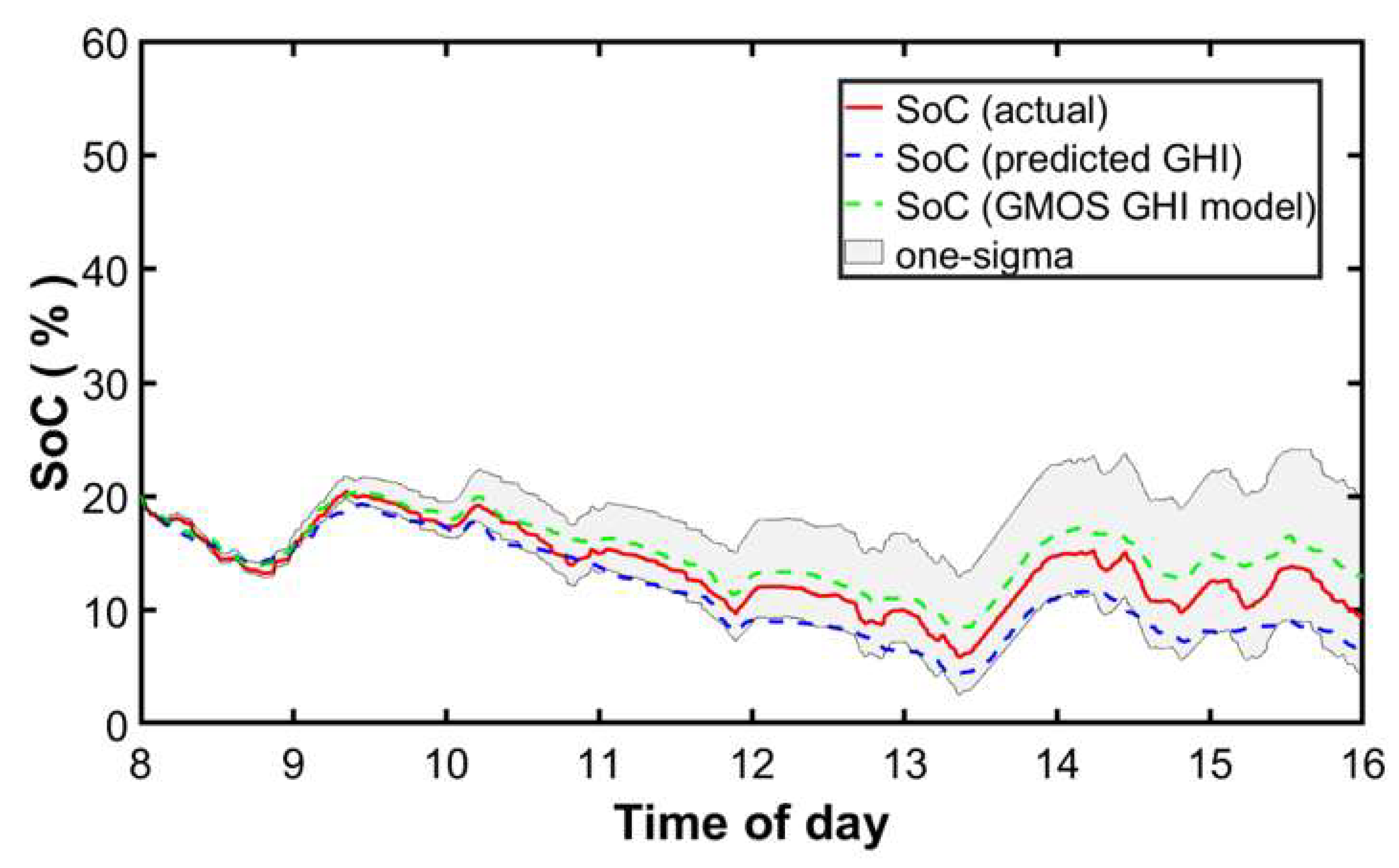
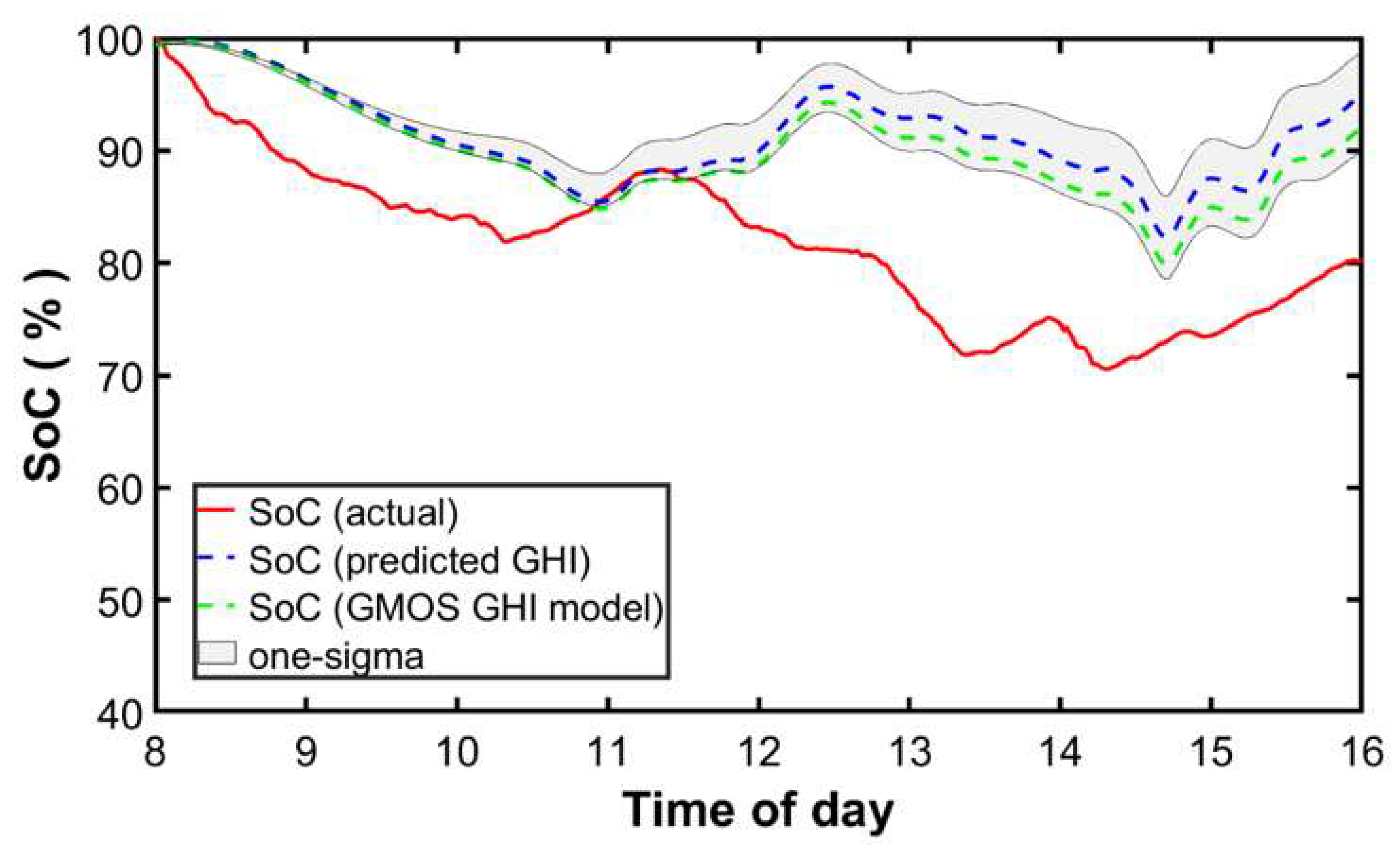
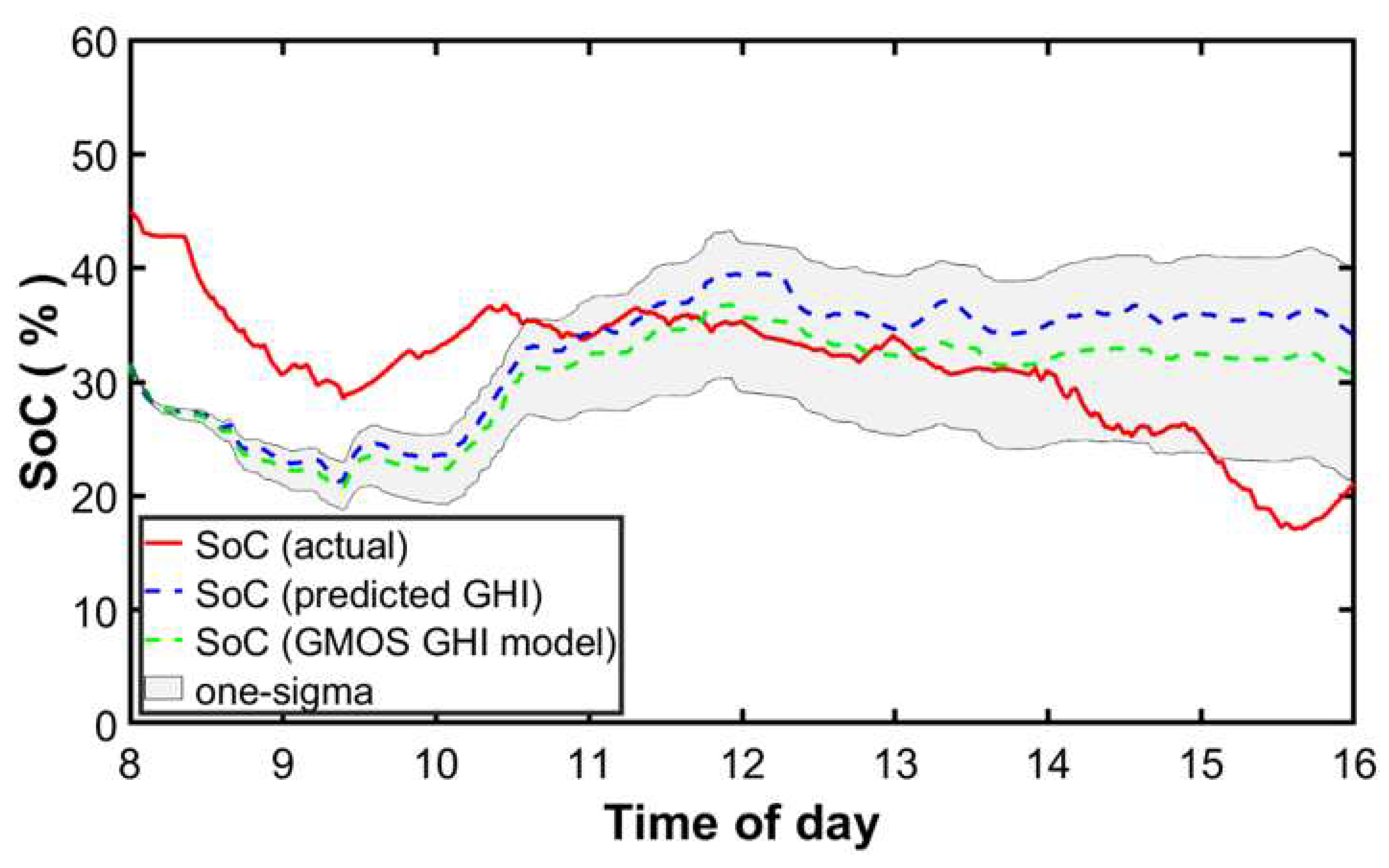
| Forecast Horizon | Clear Sky | 0% < TCC 1 ≤ 25% | 25% < TCC ≤ 50% | 50% < TCC ≤ 75% | 75% < TCC ≤ 100% | |||||
|---|---|---|---|---|---|---|---|---|---|---|
| raw | GMOS2 | raw | GMOS | raw | GMOS | raw | GMOS | raw | GMOS | |
| One | 24.3 | 8.1 | 27.2 | 16.0 | 29.8 | 17.5 | 33.6 | 21.9 | 35.5 | 26.8 |
| Two | 24.6 | 8.3 | 28.8 | 19.1 | 30.3 | 25.0 | 36.0 | 26.8 | 37.6 | 26.9 |
| Three | 22.2 | 11.5 | 25.7 | 14.4 | 28.3 | 18.1 | 34.5 | 21.4 | 36.3 | 28.8 |
| Four | 24.5 | 10.9 | 30.4 | 17.8 | 32.2 | 19.3 | 36.2 | 22.6 | 38.2 | 28.9 |
| Five | 23.0 | 10.8 | 28.7 | 15.2 | 27.7 | 14.5 | 37.0 | 24.9 | 38.3 | 22.8 |
| Six | 27.3 | 12.8 | 29.8 | 17.9 | 33.3 | 19.8 | 36.1 | 23.9 | 38.9 | 26.2 |
| Seven | 31.8 | 10.5 | 25.0 | 12.9 | 23.6 | 13.5 | 34.8 | 20.5 | 36.5 | 22.7 |
| Eight | 34.8 | 12.8 | 27.7 | 15.7 | 29.4 | 17.2 | 35.5 | 24.6 | 37.7 | 25.0 |
| Nine | 25.5 | 13.0 | 26.5 | 14.6 | 30.1 | 15.0 | 32.5 | 23.8 | 37.4 | 29.1 |
| Forecast horizon | Clear Sky | 0% < TC1 1 ≤ 25% | 25% < TCC ≤ 50% | 50% < TCC ≤ 75% | 75% < TCC ≤ 100% | |||||
|---|---|---|---|---|---|---|---|---|---|---|
| raw | GMOS2 | raw | GMOS | raw | GMOS | raw | GMOS | raw | GMOS | |
| One | 24.5 | 9.3 | 26.7 | 15.6 | 29.9 | 17.4 | 31.4 | 21.6 | 34.4 | 23.7 |
| Two | 27.1 | 8.7 | 28.5 | 20.3 | 32.1 | 18.2 | 36.3 | 25.8 | 39.7 | 25.4 |
| Three | 20.0 | 10.2 | 26.9 | 12.3 | 28.8 | 16.9 | 32.7 | 21.8 | 34.2 | 27.1 |
| Four | 24.3 | 10.9 | 29.0 | 14.5 | 30.5 | 18.8 | 34.7 | 22.6 | 36.8 | 30.0 |
| Five | 22.7 | 11.5 | 28.8 | 15.0 | 28.8 | 19.4 | 34.5 | 24.9 | 37.7 | 26.3 |
| Six | 29.4 | 11.2 | 29.5 | 17.6 | 31.8 | 20.9 | 36.7 | 24.1 | 38.3 | 28.9 |
| Seven | 31.9 | 13.0 | 23.9 | 12.9 | 26.0 | 14.0 | 34.4 | 23.3 | 33.6 | 28.1 |
| Eight | 30.5 | 11.5 | 27.4 | 15.8 | 33.7 | 16.6 | 35.6 | 23.6 | 38.8 | 29.6 |
| Nine | 26.2 | 14.5 | 27.8 | 14.2 | 29.4 | 16.3 | 34.9 | 23.8 | 35.4 | 32.9 |
| Forecast Horizon | Clear Sky | 0% < TCC 1 ≤ 25% | 25% < TCC ≤ 50% | 50% < TCC ≤ 75% | 75% < TCC ≤ 100% | |||||
|---|---|---|---|---|---|---|---|---|---|---|
| raw | GMOS2 | raw | GMOS | raw | GMOS | raw | GMOS | raw | GMOS | |
| One | 17.8 | 7.0 | 19.9 | 12.8 | 27.9 | 15.0 | 29.8 | 19.2 | 33.7 | 20.2 |
| Two | 18.4 | 7.3 | 23.9 | 12.7 | 30.0 | 12.6 | 35.1 | 20.5 | 36.9 | 22.8 |
| Three | 16.2 | 8.9 | 16.8 | 11.5 | 27.8 | 18.9 | 30.4 | 18.3 | 32.9 | 20.0 |
| Four | 16.7 | 7.9 | 28.5 | 16.7 | 30.4 | 20.8 | 36.5 | 21.3 | 37.4 | 25.7 |
| Five | 18.9 | 10.1 | 21.9 | 14.8 | 28.0 | 17.2 | 33.0 | 19.6 | 34.4 | 19.1 |
| Six | 20.5 | 9.5 | 29.2 | 15.1 | 30.3 | 21.4 | 33.5 | 22.2 | 32.3 | 28.0 |
| Seven | 22.0 | 12.8 | 23.1 | 16.8 | 23.6 | 20.0 | 28.1 | 19.2 | 32.4 | 30.0 |
| Eight | 20.4 | 15.0 | 25.4 | 15.9 | 29.9 | 18.0 | 33.5 | 22.0 | 35.2 | 27.0 |
| Nine | 21.6 | 15.7 | 20.0 | 15.4 | 28.1 | 20.1 | 32.3 | 22.7 | 34.0 | 31.1 |
| Forecast Horizon | Clear Sky | 0% < TCC 1 ≤ 25% | 25% < TCC ≤ 50% | 50% < TCC ≤ 75% | 75% < TCC ≤ 100% | |||||
|---|---|---|---|---|---|---|---|---|---|---|
| raw | GMOS2 | raw | GMOS | raw | GMOS | raw | GMOS | raw | GMOS | |
| One | 24.9 | 10.8 | 27.6 | 14.7 | 26.3 | 15.1 | 33.6 | 21.4 | 30.5 | 27.3 |
| Two | 27.1 | 11.6 | 29.4 | 12.9 | 31.8 | 15.4 | 37.5 | 26.1 | 32.8 | 33.0 |
| Three | 21.0 | 12.1 | 27.0 | 13.2 | 29.1 | 17.5 | 33.1 | 22.4 | 34.5 | 24.2 |
| Four | 24.6 | 9.2 | 28.5 | 17.5 | 32.0 | 22.2 | 35.3 | 23.0 | 38.1 | 30.5 |
| Five | 23.1 | 13.1 | 20.8 | 17.5 | 25.9 | 10.5 | 36.5 | 18.7 | 38.0 | 23.7 |
| Six | 30.6 | 14.5 | 30.6 | 15.9 | 35.4 | 18.4 | 35.9 | 26.9 | 38.5 | 34.2 |
| Seven | 31.7 | 15.8 | 25.8 | 18.3 | 20.7 | 20.8 | 34.5 | 21.4 | 32.1 | 22.3 |
| Eight | 30.5 | 15.9 | 29.0 | 16.8 | 29.9 | 22.7 | 40.1 | 30.1 | 39.8 | 24.0 |
| Nine | 32.6 | 15.3 | 27.2 | 18.4 | 25.4 | 23.3 | 34.2 | 23.2 | 37.3 | 28.6 |
| Forecast Horizon | Clear Sky | 0% < TCC 1 ≤ 25% | 25% < TCC ≤ 50% | 50% < TCC ≤ 75% | 75% < TCC ≤ 100% | |||||
|---|---|---|---|---|---|---|---|---|---|---|
| raw | GMOS2 | raw | GMOS | raw | GMOS | raw | GMOS | raw | GMOS | |
| One | 22.9 | 8.8 | 25.4 | 14.8 | 28.5 | 16.3 | 32.1 | 21.0 | 33.5 | 24.5 |
| Two | 24.3 | 9.0 | 27.7 | 16.3 | 31.1 | 17.8 | 36.2 | 24.8 | 36.8 | 27.0 |
| Three | 19.9 | 10.7 | 24.1 | 12.9 | 28.5 | 17.9 | 32.7 | 21.0 | 34.5 | 25.0 |
| Four | 22.5 | 9.7 | 29.1 | 16.6 | 31.3 | 20.3 | 35.7 | 22.4 | 37.6 | 28.8 |
| Five | 21.9 | 11.4 | 25.1 | 15.6 | 27.6 | 15.4 | 35.3 | 22.0 | 37.1 | 23.0 |
| Six | 27.0 | 12.0 | 29.8 | 16.6 | 32.7 | 20.1 | 35.6 | 24.3 | 37.0 | 29.3 |
| Seven | 29.4 | 13.0 | 24.5 | 15.2 | 23.5 | 17.1 | 33.0 | 21.1 | 33.7 | 25.8 |
| Eight | 29.1 | 13.8 | 27.4 | 16.1 | 30.7 | 18.6 | 36.2 | 25.1 | 37.9 | 26.4 |
| Nine | 26.5 | 14.6 | 25.4 | 15.7 | 28.3 | 18.7 | 33.5 | 23.4 | 36.0 | 30.4 |
| TCC1 Conditions | Meteomatics AG GHI 2 std 3 and (RMSE 4) | GMOS GHI Model std and (RMSE) |
|---|---|---|
| Clear sky | 24.8%, (25.6%) | 11.4%, (10.8%) |
| 0% < TCC ≤ 25% | 26.5%, (26.9%) | 15.5%, (15.0%) |
| 25% < TCC ≤ 50% | 29.1%, (28.2%) | 18.0%, (18.9%) |
| 50% < TCC ≤ 75% | 34.5%, (33.4%) | 22.8%, (21.7%) |
| 75% < TCC ≤ 100% | 36.0%, (36.5%) | 26.7%, (26.2%) |
| Combined mean | 30.2%, (29.2%) | 18.9%, (18.1%) |
| SSC 2018 1 Day | Date | Origin and Destination | Distance Traveled (km) | Nearest Ground Observation Stations |
|---|---|---|---|---|
| One | 22/09/2018 | Pretoria to Kroonstad via Sasolburg | 493 | Pretoria and Bloemfontein |
| Four | 25/09/2018 | Gariep Dam to Graaff-Reinet via Middelburg | 291 | Bloemfontein and Port Elizabeth |
| Six | 27/09/2018 | Port Elizabeth to Sedgefield via Kareedouw | 371 | Port Elizabeth and Stellenbosch |
| Seven | 28/09/2018 | Sedgefield to Swellendam via Mosselbay | 308 | Port Elizabeth and Stellenbosch |
| Eight | 29/09/2018 | Swellendam to Stellenbosch via Bredasdorp | 403 | Port Elizabeth and Stellenbosch |
| SSC 2018 1 Day | SoC 2 RMSE 3: Predicted GHI 4 | SoC RMSE: GMOS GHI | Final SoC: Actual | Final SoC: Predicted GHI | Final SoC: GMOS 5 GHI |
|---|---|---|---|---|---|
| One | 1.62 | 1.40 | 51.04 | 58.06 | 56.51 |
| Four | 11.62 | 9.65 | 79.89 | 95.20 | 92.21 |
| Six | 1.02 | 0.75 | 45.22 | 53.85 | 49.21 |
| Seven | 14.32 | 10.98 | 20.07 | 35.14 | 31.25 |
| Eight | 2.01 | 1.16 | 10.10 | 6.18 | 13.31 |
| SSC 2018 1 Day | SoC 2 RMSE 3: MOS 4 GHI 5 (Rear Location) | SoC RMSE: MOS GHI (Front Location) | SoC RMSE: GMOS 6 GHI | Final SoC: Actual | Final SoC: MOS GHI (Rear Location) | Final SoC: MOS GHI (Front Location) | Final SoC: GMOS GHI |
|---|---|---|---|---|---|---|---|
| One | 1.49 | 1.52 | 1.40 | 51.04 | 57.11 | 57.68 | 56.51 |
| Six | 0.88 | 0.87 | 0.75 | 45.22 | 51.01 | 49.82 | 49.21 |
| Eight | 1.32 | 1.06 | 1.16 | 10.10 | 13.93 | 12.89 | 13.31 |
© 2020 by the authors. Licensee MDPI, Basel, Switzerland. This article is an open access article distributed under the terms and conditions of the Creative Commons Attribution (CC BY) license (http://creativecommons.org/licenses/by/4.0/).
Share and Cite
Oosthuizen, C.; Van Wyk, B.; Hamam, Y.; Desai, D.; Alayli, Y. The Use of Gridded Model Output Statistics (GMOS) in Energy Forecasting of a Solar Car. Energies 2020, 13, 1984. https://doi.org/10.3390/en13081984
Oosthuizen C, Van Wyk B, Hamam Y, Desai D, Alayli Y. The Use of Gridded Model Output Statistics (GMOS) in Energy Forecasting of a Solar Car. Energies. 2020; 13(8):1984. https://doi.org/10.3390/en13081984
Chicago/Turabian StyleOosthuizen, Christiaan, Barend Van Wyk, Yskandar Hamam, Dawood Desai, and Yasser Alayli. 2020. "The Use of Gridded Model Output Statistics (GMOS) in Energy Forecasting of a Solar Car" Energies 13, no. 8: 1984. https://doi.org/10.3390/en13081984
APA StyleOosthuizen, C., Van Wyk, B., Hamam, Y., Desai, D., & Alayli, Y. (2020). The Use of Gridded Model Output Statistics (GMOS) in Energy Forecasting of a Solar Car. Energies, 13(8), 1984. https://doi.org/10.3390/en13081984





